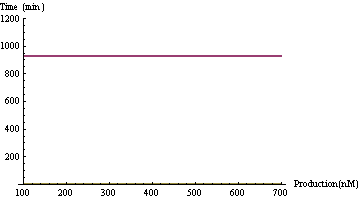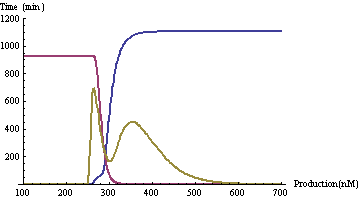|
Modeling > Result
After ODE and Parameters, it's time to see the simulation result.
The Goal of Simulation
Of course, the ultimate goal of modeling is to simulate the circuit as accurate as possible. However, due to the complexity of biological system and very little we have known about it, it's almost impossible to simulate exactly. Thus, we come up a series of standards, which will be the main goals of our modeling. Here're the standards:
- The Biological System Should Follow the Truth Table
As we mentioned in project section, the dog (and of course the model) should react in a specific way under certain circumstances, which has been concluded into a truth table. To simulate perfectly, our model should follow the truth table, which is the primary goal without doubt.
| NO MEMORY
| WITH MEMORY
|
| FOOD
| BELL
| OUTPUT
| FOOD
| BELL
| OUTPUT
|
| 0
| 0
| 0
| 0
| 0
| 0
|
| 1
| 0
| 1
| 1
| 0
| 1
|
| 0
| 1
| 0
| 0
| 1
| 1
|
| 1
| 1
| 1
| 1
| 1
| 1
|
- The Result Should Fit A Dog's Reaction
OK, what we do this year is to simulate Pavlov's dog. Thus, our modeling should not only concentrate on biological mechanism, but also follow a dog's reaction towards certain things. Here're some circumstance we've thought up. If you have new ideas, feel free to email us! Please email to c.z.tian AT gmail.com
GFP output should be stronger under a food stimulus
Food is a direct stimulus while bell is a more indirect one. Generally, under direct stimulus, the dog will react stronger.
If the dog has memory and is given a bell stimulus, GFP output should have a delay
The dog takes time to link BELL with FOOD :]
- The Value for Each Parameter Should NOT Be Too Extreme
This is also an attemp to simulate the system as accurately as possible.
Now, let's see the result!
Result - T3 RNA Polymerase
Here we'll demonstrate dynamics of GFP(output,shows how strongly the dog reacts), CI and CI434(bistable switch, represents the memory). In the figures below, CI was represented by pink line, CI434 was represented by blue line while yellow line shows the dynamics of GFP output.
| Situations
| Simulation Result | Remarks and Explanations
|
| No Memory
| Food | 
| We give the dog a food stimulus at 250 min, and we can see there's a large GFP peak, which means the dog reacts to the food. Since there's no training, the memory state(CI, CI434) doesn't change
|
| Bell
| 
| We only give the dog a bell stimulus at 250 min. The memory state is not affected by this process, and we can't see any dynamics of GFP in this figure.
|

| However, if we zoom in, there's a small GFP peak, which we regard as no output.
|
| Food+Bell | 
| At 250 min, both food stimulus and bell stimulus are presented. The dog reacts strongly.
|
Result - P2
^Top
|